Mechanical Site Preparation for Forestry in Mississippi
Site preparation is a general term used to describe silvicultural treatments applied to logging debris, vegetation, the forest floor, or soil to make the site suitable for regeneration. Two different categories of site preparation are used in forestry: chemical and mechanical. Chemical site preparation involves applying herbicides to control vegetation that could compete with planted seedlings. This practice is probably more familiar to most forest landowners today than mechanical work, which was more prevalent before the advent of affordable forest herbicides. Chemical site preparation is cheaper to implement than mechanical treatments and has less potential for damaging the site. Therefore, chemical site preparation is used much more extensively than mechanical methods.
Nevertheless, mechanical site preparation may be necessary to correct certain physical site issues. These include residual debris, poor drainage, compaction, and rutting. Since mechanical site preparation may involve the physical disturbance of soils, understanding its effects on site productivity is essential. Mechanical site preparation techniques are still used in some situations because they can achieve a particular goal that chemical site preparation alone cannot. This publication will discuss both pros and cons of mechanical treatments for site preparation in Mississippi. Treatment expenses are estimated based on average costs in the southeastern United States.
The Soil Resource
Soil is formed through a series of complex physical, chemical, and biological interactions. These interactions are driven by climate and influenced on a smaller scale by local topography and biota. All of these factors working together transform geologic material into soil over long periods of time. Soil development can require hundreds to thousands of years, which means soil is not considered to be a renewable resource. Soil conservation, then, is extremely important when using mechanical disturbance to prepare a site for regeneration.
In forested soils, organic matter accumulates as the litter layer on top of mineral soil in the form of fallen leaves, branches, and fruit. The litter layer acts much like mulch, insulating soil from extremes of heat and cold. Decomposition of this litter into humus provides food to a host of soil organisms, as well as nutrients to plants and animals. These soil organisms mix decomposing humus into the upper mineral soil, forming topsoil. In the warm, humid climate of Mississippi, most nutrient recycling within the forest ecosystem occurs in the topsoil. This topsoil drives site quality, and its protection is crucial to maintaining site productivity.

Mowing
Mowing, also known as clipping or bush hogging, involves severing vegetation (herbaceous and small-diameter woody species) near ground level using a bush hog or other similar implement. This practice is probably the most familiar of the mechanical treatments discussed in this publication. However, it is also probably the least beneficial from a forestry or wildlife standpoint. Very little soil disturbance takes place when mowing, so it cannot be used to correct soil compaction and drainage problems. In addition, mowing does not typically kill competing vegetation—soon after treatment, mown vegetation regrows.
The primary benefit of mowing as a mechanical treatment is improved planting conditions. Planting seedlings is more efficient, and proper plant spacing is more easily obtained for a short period of time after mowing. This can result in lower planting costs in some situations. While mowing is not typically used for site preparation in forest management, vendors should be easy to find. Per-acre costs should average somewhere between $35 for retired fields or pastures to $60 in areas with numerous small, woody stems.
Another form of mowing, known as mulching or shredding, involves using specialized equipment to clear older, larger-diameter woody stems that disrupt planting or other management goals. This form of site preparation is too costly ($200 to $500 per acre) for the vast majority of forestry site preparation situations. However, mulching is sometimes used for clearing small acreages in urban settings and in some wildlife management efforts. As with traditional mowing efforts, mulching rarely provides adequate long-lasting control of the vegetation that it initially removes, so the practice is typically considered of low value in most forestry applications.

Shearing

Natural regeneration of less desirable species and logging debris can pose problems in regeneration efforts of harvested areas. Logging debris and residual stems can also impede planting. Attempts to correct these problems with mechanical treatments generally include shearing, chopping, or a combination of mechanical techniques. Shearing involves attaching a blade to the front of a bulldozer and cutting (shearing) residual stems or woody debris on the desired area. Two types of blades have been used for shearing. A large, slanted, sharpened blade with a sharpened point at one end (K-G blade) was the most widely used in the 1970s and 1980s. Beginning in the 1990s, managers started using a V-shaped blade with a sharpened point on the front of the V. Residual stems are cut at ground level, and logging debris is displaced to the side, thereby clearing a lane for planting. For this reason, shearing usually lowers planting costs. Very little shearing is used currently, so vendors are relatively hard to find. Treatment costs will vary but average around $200 per acre.
One negative feature often associated with shearing is stump sprouting of less desirable species. Several studies have reported an increase in stocking of light-seeded, fast-growing pioneer species like sweetgum compared to heavier-seeded, slower-growing species like oaks. If species like sweetgum are undesirable or controlling woody vegetation is a priority, shearing is not recommended.
Research has shown that shearing may cause increased soil compaction and decreased soil organic matter. The weight of bulldozers used to perform shearing can cause compaction in the upper layers of soil. Furthermore, if operators are not careful during shearing efforts, displaced residual stems and logging debris can easily result in a reduction in soil organic matter content. This loss is intensified if the site is windrowed, which is when sheared material is pushed into rows across the area being treated. These rows are often burned to remove the consolidated debris. The practice typically removes much of a site’s nutrient load and deposits it in relatively narrow bands.
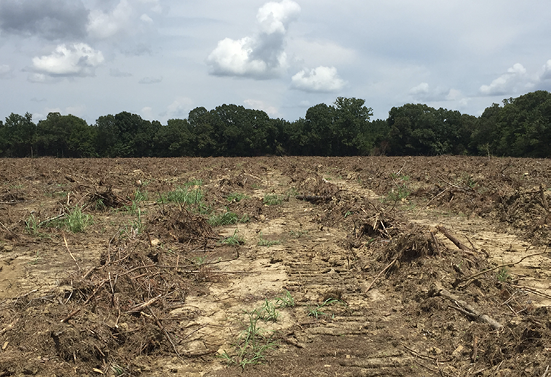

Chopping
Chopping or roller-drum chopping consists of pulling one or two cylindrical metal drums, usually filled with water and with large blades attached, with a bulldozer across a site in an attempt to crush and chop residual vegetation and logging debris. This is done to provide easy access for planting crews and to reduce vegetative competition. However, chopping often does not provide acceptable results; chopped vegetation often resprouts. Most research indicates that chopping is relatively ineffective in killing hardwoods. In addition, because it is broken up into smaller pieces, organic matter decays rapidly in chopped areas, which may lower nutrient availability to planted seedlings.
Besides failing to control competition, chopping is relatively ineffective as a means of correcting soil compaction or drainage issues. If residual stem and debris disposal are of little concern, chopping has little to no benefit. While not as damaging as shearing and windrowing, equipment passes back and forth over the treated area during chopping and may result in soil compaction problems. Similar to shearing, vendors that offer chopping as a treatment may be difficult to find. If a vendor can be found nearby, chopping costs per acre should be around $150.
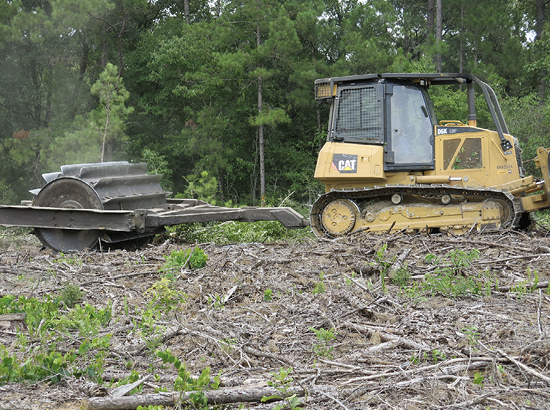
Disking
One negative effect of site preparation treatments such as shearing and chopping is the possibility of increasing undesirable woody species. This is less of a problem in areas being disked regularly, and of minimal concern on former agricultural areas. Disking typically involves pulling a double-gang disk across the site to be regenerated. The soil is mixed and loosened, and competing plant roots are severed. Disking is sometimes recommended for site preparation of retired fields to encourage establishment of light-seeded tree species. However, research has shown as many as twice the number of stems of light-seeded tree species (e.g., sweetgum, elm, sugarberry, cottonwood, sycamore, ash) in undisked areas compared to disked areas. This is most likely caused by formation of large soil clods, which increase soil drying and temperature.

Disking can, however, improve growth and survival of planted seedlings. Some research has indicated that seedlings planted in disked areas exhibited greater height growth, diameter growth, and seedling survival than those planted in undisked areas. In contrast, other studies have contradicted these findings, indicating either negative or insignificant effects on survival and growth of planted seedlings. Several of these studies have observed that subsoiling may be a more appropriate technique for breaking compaction layers in retired agricultural areas in the Lower Mississippi Alluvial Valley. Subsoiling often incurs less cost, creates less potential for erosion, and is generally more effective. In addition, subsoiling does not encourage the flush of competing herbaceous vegetation commonly resulting from disking.

Disking for forestry site preparation is rarely used. As a result, vendors offering the treatment may be difficult to find, especially in areas with difficult terrain or heavy debris loads. Per-acre costs will range from $20 in former agricultural field settings to $75 on cutover tracts.

Subsoiling
Subsoiling, also known as ripping, is a practice that fractures restrictive layers often found in retired agricultural fields. It can increase tree growth and survival by solving the problems associated with compacted soils. Studies have indicated improved seedling height and diameter growth as a result of increased moisture availability, more uniform planting depths, better deep-root development, and subsequent soil exploitation. These benefits are especially helpful in low-moisture and low-fertility conditions because seedlings are able to absorb nutrients and water more readily and efficiently. Subsoiling also helps achieve accurate seedling densities. Once performed, planting crews can plant along the subsoil slit without concern for row spacing.

Conventional subsoiling is performed by pulling a 3- to 6-inch-wide shank through the soil behind a tractor. Typical cutting depths are between 16 and 24 inches using straight or parabolic shanks with or without winged tips. A problem associated with traditional subsoiling is the time needed for the trench (also known as a slit) to close properly. Sometimes as much as a year and several rain events are needed for proper closure of large trenches created by wide shanks. Soil drying during the growing season can cause open cracks resulting in seedling mortality when root systems are exposed to the drying effects of air in these opened trenches. In addition, large soil clods (especially in heavy clay soils) often form along the subsoil trench when using parabolic shanks. These may impede tree planting. Both of these soil conditions can cause substantial problems.
No-till subsoil systems can minimize soil disturbance in forestry site preparation. These no-till subsoil systems are primarily used in retired fields or pastures and use a ¾- to ١-inch-wide straight shank with or without a winged tip. Cutting depths are typically between 15 and 18 inches. These subsoil units are specifically designed to prevent surface disturbance and large clods in heavy clay soils. Planting can proceed as soon as 1 month post-treatment. Cracking along the subsoil trench may still occur but is much less likely.
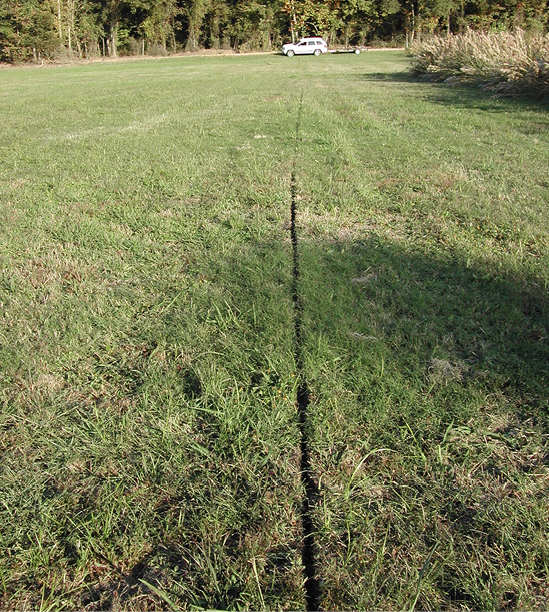
Whether using a no-till or traditional system, subsoiling exposes less mineral soil than other forms of mechanical site preparation. This is beneficial because undesirable pioneer woody species need mineral soil for establishment. Of the various mechanical treatments available, subsoiling is typically less expensive and more easily performed because contractors are readily available and the treatment is simple to implement. When using agricultural equipment to subsoil former agricultural fields, the practice may cost less than $35 per acre. However, when subsoiling for typical forestry prescriptions, costs average between $60 and $80 per acre. A notable exception to this pricing is in clearcuts, which often have downed woody material, stumps, and steep terrain. Subsoiling in clearcut scenarios typically costs between $100 and $125 per acre.

Bedding
Bedding, also known as hipping or mounding, is typically performed using a moldboard plow, offset disk, levee plow, or furrow plow. Soil is turned inward, creating a planting bed 3 to 6 feet wide and between 6 inches and 2 feet high. Bedding is typically used to establish seedlings on poorly drained soils. Because bedding raises seedling roots out of on-site water, increased seedling survival has been documented in areas that were inundated or saturated regularly.
Bedding can also increase early growth of seedlings through improved soil aeration and drainage, concentrated organic matter and nutrients, and short-term competition control. However, bedding has proven harmful when used on some drier sites. When considering bedding as a site preparation option, remember that the practice is designed to elevate root systems above saturated soils. When used properly, the benefits are obvious. Conversely, when used on dry sites or in drought years, bedding may result in increased seedling mortality when seedling roots dry out. When using agricultural equipment to bed retired agricultural fields, bedding typically costs $75 per acre, but can range upward of $140 in cutover settings that require bulldozers.
Combination Plowing
Combination plowing combines subsoiling and bedding into one mechanical treatment. Typically, a subsoil shank and coulter are pulled in front of a bedding plow. Problems with soil compaction, poor drainage, and vegetative competition are reduced, and growth and survival of planted seedlings is improved. This technique is relatively common in pine plantation establishment on upland sites and has provided satisfactory growth and survival results; however, it has not been widely used in hardwood efforts. This is primarily because of the cost—$200 or more per acre for low logging debris/flat sites—and carrying that cost throughout a lengthy rotation of hardwood timber.

Combination plowing for forestry site preparation is expensive (but cheaper than multiple passes). Consequently, most landowners do not elect to use the treatment. However, it is available through a number of vendors. Costs increase with increases in logging debris and difficulty of terrain.
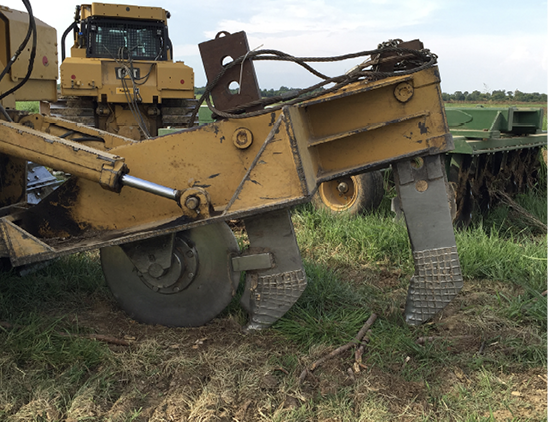

Figures 14 and 15. Offset double-shank subsoil system often used in cutovers. Note heavy-duty construction for increased shear-stress on tracts with increased roots and stumps.
Summary
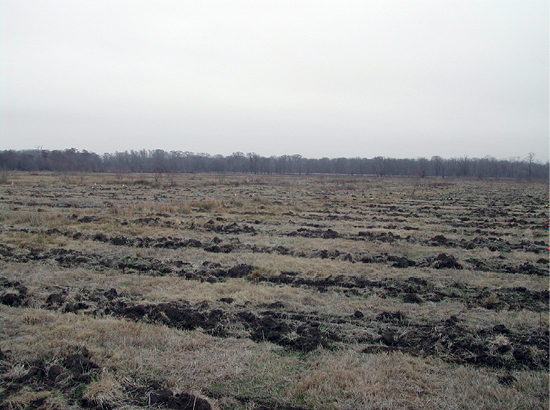
Mechanical site preparation can be useful for regeneration efforts. However, performing effective mechanical site preparation can be cost-prohibitive in some cases. Choose site preparation methods on a case-by-case basis, and consult with a forestry professional when selecting appropriate forestry management techniques. Give careful consideration to site-specific soil conditions, techniques that might be used to correct problems, and the budget available to perform mechanical site preparation.

Additional Reading
Allen, J. A., B. D. Keeland, J. A. Stanturf, A. F. Clewell, & H. E. Kennedy, Jr. 2001. A guide to bottomland hardwood restoration. U.S. Department of Agriculture, Forest Service Southern Research Station, Gen. Tech. Rep. SRS-40, 132 p.
Ezell, A. W. & M. W. Shankle. 2004. Effects of subsoiling and competition control on first year survival and growth of four hardwood species. Proceedings of 12th Biennial Southern Silvicultural Research Conference. U.S. Department of Agriculture, Forest Service: Gen. Tech. Rep. SRS-71. p. 571–573.
Kushla, J. D. & L. Oldham. 2020. Forest Soils of Mississippi. Mississippi State University Extension Publication 2822. Mississippi State, MS, 7p.
Patterson, W. B. & J. C. Adams. 2003. Soil, hydroperiod, and bedding effects on restoring bottomland hardwoods on flood-prone agricultural lands in north Louisiana, USA. Forestry 76(2): 181–188.
Pritchett, W. L. & R. F. Fisher. 1987. Properties and Management of Forest Soils, 2nd ed. Wiley and Sons, New York. 512 p.
Self, A. B., A. W. Ezell, D. Rowe, E. B. Schultz, J. D. Hodges. 2012. Effects of mechanical site preparation on growth of oaks planted on former agricultural fields. Forests 3(1): 22–32.
Self, A. B., A. W. Ezell, A. J. Londo, J. D. Hodges, & D. K. Alkire. 2012. Evaluation of site preparation and planting stock on Nuttall oak and cherrybark oak growth on a former agriculture area. Proceedings of 16th Biennial Southern Silvicultural Research Conference. USDA Forest Service e-General Technical Report SRS-156. p. 308–313.
Stanturf, J. A., W. H. Conner, E. S. Gardiner, C. J. Schweitzer, & A. W. Ezell. 2004. Recognizing and overcoming difficult site conditions for afforestation of bottomland hardwoods. Ecological Restoration 22(3): 183–193.
The information given here is for educational purposes only. References to commercial products, trade names, or suppliers are made with the understanding that no endorsement is implied and that no discrimination against other products or suppliers is intended.
Publication 3006 (POD-10-22)
By Brady Self, PhD, Associate Extension Professor, Forestry, and John D. Kushla, PhD, Extension/Research Professor, Forestry.
The Mississippi State University Extension Service is working to ensure all web content is accessible to all users. If you need assistance accessing any of our content, please email the webteam or call 662-325-2262.




